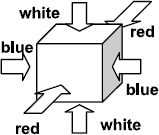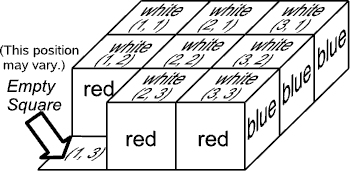POJ-3131-Cubic Eight-Puzzle(双向BFS+哈希)
Description
Let’s play a puzzle using eight cubes placed on a 3 × 3 board leaving one empty square.
Faces of cubes are painted with three colors. As a puzzle step, you can roll one of the cubes to a adjacent empty square. Your goal is to make the specified color pattern visible from above by a number of such steps.
The rules of this puzzle are as follows.
Coloring of Cubes: All the cubes area colored in the same way as shown in Figure 1. The opposite faces have the same color.

Figure 1: Coloring of a cube
Initial Board State: Eight cubes are placed on the 3 × 3 board leaving one empty square. All the cubes have the same orientation as shown in Figure 2. As shown in the figure, squares on the board are given x and y coordinates,
(1, 1), (1, 2), …, and (3, 3). The position of the initially empty square may vary.
Figure 2: Initial board state
Rolling Cubes: At each step, we can choose one of the cubes adjacent to the empty square and roll it into the empty square, leaving the original position empty. Figure 3 shows an example.

Figure 3: Rolling a cube
Goal: The goal of this puzzle is to arrange the cubes so that their top faces form the specified color pattern by a number of cube rolling steps described above.
Your task is to write a program that finds the minimum number of steps required to make the specified color pattern from the given initial state.
Input
The input is a sequence of datasets. The end of the input is indicated by a line containing two zeros separated by a space. The number of datasets is less than 16. Each dataset is formatted as follows.
x y F11 F21 F31 F12 F22 F32 F13 F23 F33
The first line contains two integers x and y separated by a space, indicating the position (x, y) of the initially empty square. The values of x and y are 1, 2, or 3.
The following three lines specify the color pattern to make. Each line contains three characters F1j, F2j, and F3j, separated by a space. Character Fij indicates
the top color of the cube, if any, at the position (i, j) as follows:
B:Blue,
W:White,
R:Red,
E:the square is Empty.
There is exactly one ‘E’ character in each dataset.
Output
For each dataset, output the minimum number of steps to achieve the goal, when the goal can be reached within 30 steps. Otherwise, output “-1” for the dataset.
Sample Input
1 2
W W W
E W W
W W W
2 1
R B W
R W W
E W W
3 3
W B W
B R E
R B R
3 3
B W R
B W R
B E R
2 1
B B B
B R B
B R E
1 1
R R R
W W W
R R E
2 1
R R R
B W B
R R E
3 2
R R R
W E W
R R R
0 0
Sample Output
0
3
13
23
29
30
-1
-1
Source
思路:数据太大,先抽象出状态,再哈希一下,然后就是双向BFS。
#include <stdio.h>
#include <string.h>
#include <stack>
using namespace std;
#define INF 99999999
struct{
int step,state;
}t,que1[1000000],que2[1000000];
stack<int>stk;
bool vis1[5000007],vis2[5000007];
int top1,top2,bottom1,bottom2,mp[9],nxt[2][7]={{0,4,6,5,1,3,2},{0,5,3,2,6,1,4}},head[5000007],next[5000007],val[5000007],total;
int hashval(int x)
{
int t,i;
t=x%5000007;
for(i=head[t];i!=-1;i=next[i])
{
if(val[i]==x) return i;
}
val[total]=x;
next[total]=head[t];
head[t]=total;
total++;
return total-1;
}
void pushtarget(int cnt,int state)
{
if(cnt==-1)
{
vis2[hashval(state)]=1;
que2[bottom2].step=0;
que2[bottom2].state=state;
bottom2++;
return;
}
if(mp[cnt]%2)
{
pushtarget(cnt-1,state*7+mp[cnt]);
pushtarget(cnt-1,state*7+mp[cnt]+1);
}
else pushtarget(cnt-1,state*7);
}
int getstate()
{
int temp=0;
for(int i=8;i>=0;i--)
{
temp=temp*7+mp[i];
}
return temp;
}
void spread(int x)
{
int i=0,temp,cnt,old;
while(i<9)
{
if(x%7==0) cnt=i;
mp[i++]=x%7;
x/=7;
}
cnt+=1;
if(cnt>=0 && cnt<9 && cnt%3>0)
{
old=mp[cnt];
mp[cnt-1]=nxt[0][mp[cnt]];
mp[cnt]=0;
stk.push(getstate());
mp[cnt]=old;
mp[cnt-1]=0;
}
cnt-=1;
cnt-=1;
if(cnt>=0 && cnt<9 && cnt%3<2)
{
old=mp[cnt];
mp[cnt+1]=nxt[0][mp[cnt]];
mp[cnt]=0;
stk.push(getstate());
mp[cnt]=old;
mp[cnt+1]=0;
}
cnt+=1;
cnt-=3;
if(cnt>=0 && cnt<9)
{
old=mp[cnt];
mp[cnt+3]=nxt[1][mp[cnt]];
mp[cnt]=0;
stk.push(getstate());
mp[cnt]=old;
mp[cnt+3]=0;
}
cnt+=3;
cnt+=3;
if(cnt>=0 && cnt<9)
{
old=mp[cnt];
mp[cnt-3]=nxt[1][mp[cnt]];
mp[cnt]=0;
stk.push(getstate());
mp[cnt]=old;
mp[cnt-3]=0;
}
cnt-=3;
}
int bfs()
{
int step1=0,step2=0,ans=INF,temp;
for(step1=0;step1<=20;step1++)
{
while(top1<bottom1 && que1[top1].step==step1)
{
spread(que1[top1].state);
while(!stk.empty())
{
temp=stk.top();
stk.pop();
if(vis2[hashval(temp)])
{
return step1+step2+1;
}
if(!vis1[hashval(temp)])
{
vis1[hashval(temp)]=1;
que1[bottom1].state=temp;
que1[bottom1].step=que1[top1].step+1;
bottom1++;
}
}
top1++;
}
while(top2<bottom2 && que2[top2].step==step2 && step2<9)
{
spread(que2[top2].state);
while(!stk.empty())
{
temp=stk.top();
stk.pop();
if(vis1[hashval(temp)]) return step1+step2+2;
if(!vis2[hashval(temp)])
{
vis2[hashval(temp)]=1;
que2[bottom2].state=temp;
que2[bottom2].step=step2+1;
bottom2++;
}
}
top2++;
}
if(step2<9) step2++;
}
return -1;
}
int main()
{
int x,y,i,j,temp;
char ctemp;
while(~scanf("%d%d",&y,&x) && x)
{
x--;
y--;
top1=top2=bottom1=bottom2=0;
memset(vis1,0,sizeof vis1);
memset(vis2,0,sizeof vis2);
memset(head,-1,sizeof head);
total=0;
while(!stk.empty()) stk.pop();
for(i=0;i<9;i++)
{
ctemp=getchar();
if(ctemp=='\n' || ctemp==' ')
{
i--;
continue;
}
if(ctemp=='W')mp[i]=1;
else if(ctemp=='B') mp[i]=3;
else if(ctemp=='R') mp[i]=5;
else if(ctemp=='E') mp[i]=0;
}
pushtarget(8,0);
temp=0;
for(i=8;i>=0;i--)
{
if(i!=x*3+y) temp=temp*7+1;
else temp*=7;
}
if(vis2[hashval(temp)])
{
printf("0\n");
continue;
}
vis1[hashval(temp)]=1;
que1[bottom1].step=0;
que1[bottom1].state=temp;
bottom1++;
printf("%d\n",bfs());
}
}POJ-3131-Cubic Eight-Puzzle(双向BFS+哈希)的更多相关文章
- UVA-1604 Cubic Eight-Puzzle (双向BFS+状态压缩+限制搜索层数)
题目大意:立体的八数码问题,一次操作是滚动一次方块,问从初始状态到目标状态的最少滚动次数. 题目分析:这道题已知初始状态和目标状态,且又状态数目庞大,适宜用双向BFS.每个小方块有6种状态,整个大方格 ...
- poj 3131 Cubic Eight-Puzzle 双向广搜 Hash判重
挺不错的题目,很锻炼代码能力和调试能力~ 题意:初始格子状态固定,给你移动后格子的状态,问最少需要多少步能到达,如果步数大于30,输出-1. 由于单向搜索状态太多,搜到二十几就会爆了,所以应该想到双向 ...
- POJ 1915 经典马步 双向bfs
拿这个经典题目开刀...........可是双向时间优势在这题上的效果不太明显 #include <iostream> #include <algorithm> #includ ...
- Eight (HDU - 1043|POJ - 1077)(A* | 双向bfs+康拓展开)
The 15-puzzle has been around for over 100 years; even if you don't know it by that name, you've see ...
- POJ 3170 Knights of Ni (暴力,双向BFS)
题意:一个人要从2先走到4再走到3,计算最少路径. 析:其实这个题很水的,就是要注意,在没有到4之前是不能经过3的,一点要注意.其他的就比较简单了,就是一个双向BFS,先从2搜到4,再从3到搜到4, ...
- POJ 3126 Prime Path 解题报告(BFS & 双向BFS)
题目大意:给定一个4位素数,一个目标4位素数.每次变换一位,保证变换后依然是素数,求变换到目标素数的最小步数. 解题报告:直接用最短路. 枚举1000-10000所有素数,如果素数A交换一位可以得到素 ...
- POJ 1915-Knight Moves (单向BFS && 双向BFS 比)
主题链接:Knight Moves 题意:8个方向的 马跳式走法 ,已知起点 和终点,求最短路 研究了一下双向BFS,不是非常难,和普通的BFS一样.双向BFS只是是从 起点和终点同一时候開始搜索,可 ...
- [poj] 2549 Sumsets || 双向bfs
原题 在集合里找到a+b+c=d的最大的d. 显然枚举a,b,c不行,所以将式子移项为a+b=d-c,然后双向bfs,meet int the middle. #include<cstdio&g ...
- POJ——3126Prime Path(双向BFS+素数筛打表)
Prime Path Time Limit: 1000MS Memory Limit: 65536K Total Submissions: 16272 Accepted: 9195 Descr ...
随机推荐
- MapReduce原理<转>
江湖传说永流传:谷歌技术有"三宝",GFS.MapReduce和大表(BigTable)! 谷歌在03到06年间连续发表了三篇很有影响力的文章,分别是03年SOSP的GFS,04年 ...
- jQuery 中 attr() 和 prop() 方法的区别<转>
前几天,有人给 Multiple Select 插件 提了问题: setSelects doesn't work in Firefox when using jquery 1.9.0 一直都在用 jQ ...
- Ubuntu Mysql 安装
下载 http://dev.mysql.com/downloads/mysql/ 选择 Linux- Generic 选择版本 wget http://cdn.mysql.com/Downloads/ ...
- STL容器:list双向链表学习
list是一个双向列表容器,完成了标准C++数据结构中链表的所有功能; list与vector和deque类似,只不过其中的对象提供了对元素的随机访问. STL以双向链表的方式实现list,访问需要从 ...
- hdu 4715(打表)
题目链接:http://acm.hdu.edu.cn/showproblem.php?pid=4715 思路:先打个素数表,然后判断一下就可以了. #include<iostream> # ...
- python入门(七):CGI编程
CGI CGI(Common Gateway Interface),通用网关接口,HTTP服务器与你的或其它机器上的程序进行“交谈”的一种工具,其程序须运行在网络服务器上. CGI在其中扮演的是在we ...
- Appium自动化测试3之获取apk包名和launcherActivity后续
接着“Appium自动化测试3之获取apk包名和launcherActivity”章节介绍 测试脚本 1.测试脚本如下: # -*- coding:utf-8 -*- import os, time, ...
- 调用PostgreSQL存储过程,找不到函数名的问题
PostgreSQL的表,函数名称都是严格区分大小写的,所以在使用的时候没有注意大小写问题容易导致找不到函数名的错误,但最近两天我们发现,如果函数参数使用了自定义的数据类型,也会发生这个问题. 问题描 ...
- 内存泄露,GC相关
内存泄露就是对象不在GC的掌控之内 下面对象会发生内存泄露现象: 1.没有引用的对象 2.虚,软,弱 引用对象 GC引用的对象指的是 1.JavaStack中引用的对象 2.方法区中静态引用指向的对象 ...
- 说说M451例程讲解之串口
/**************************************************************************//** * @file main.c * @ve ...
